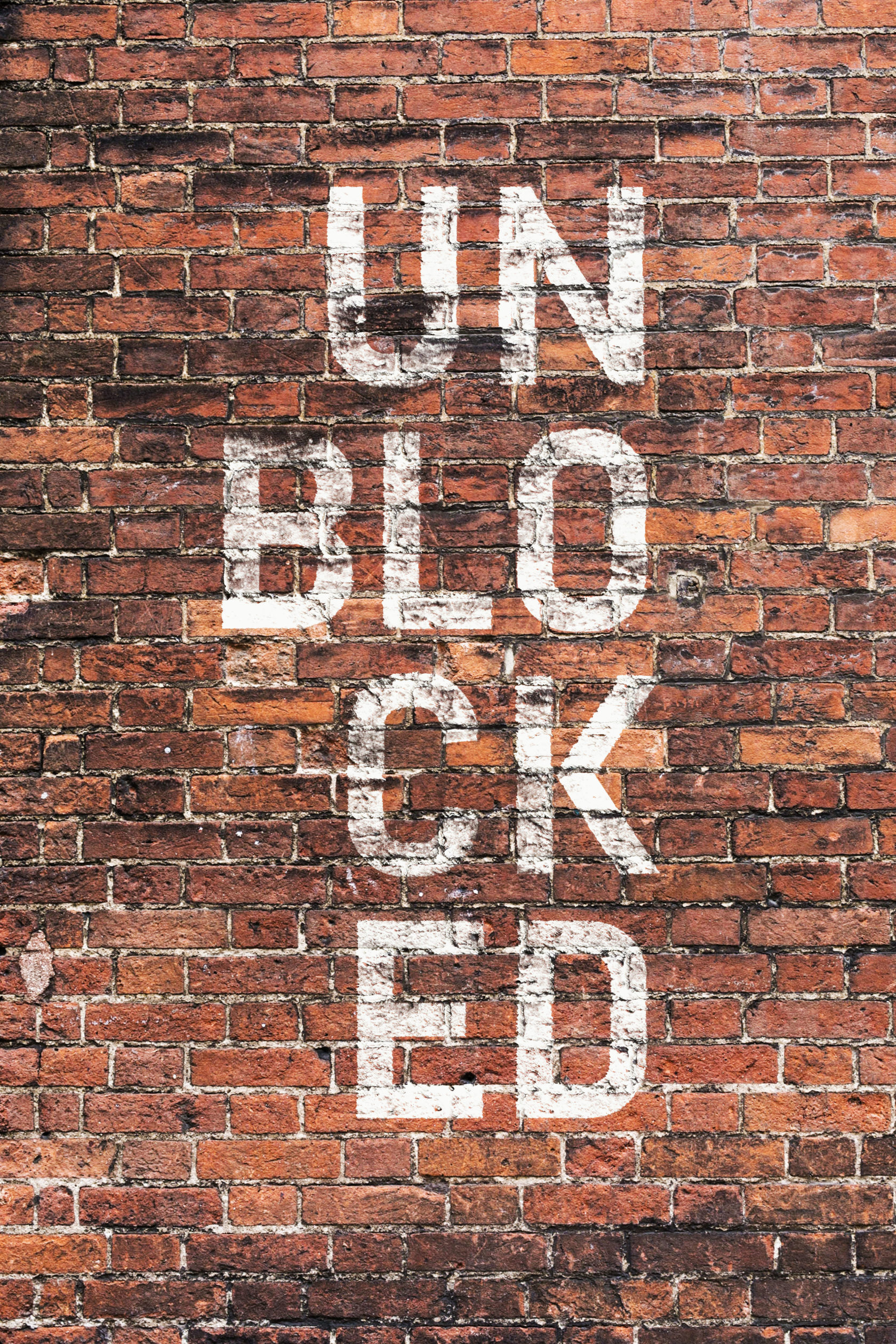Boom! You hit the wall.
You’ve gathered ideas, got some inspiration and now you’re trying to get started, but it just seems like you can’t get past this wall. You might be asking, ”How do I get ‘unblocked’?!”—well, you’ve come to the right place. Let’s talk about creative block and how to stay in your creative flow.
What is Creative Block?
Creative block is that moment when you feel that you can’t push forward, because your thoughts and ideas aren’t heading in the direction you intended. What’s coming out doesn’t match the image you had in your head.
First, this may be shocking, but creative block is a myth. You see, the problem is not that you’ve hit a creative wall, it’s that you have a) expectations and b) an editing system that impede the free flow of creativity. Our natural default mode is “edit as we go.”
The truth is, we’ve all been there. It happens to the best of us. Or does it? Creative block is something that has become a cliché of sorts. Everyone seems to relate to the idea of getting “stuck,” “hitting the wall,” getting lost in a “brain fog.” And that might be exactly what brought you here today.
Expectations and Editing Systems Block Creative Flow
As we work, we edit and revise, and make sure every step looks good. We’re taught this in primary school, and as we’ve grown, most of us lose the ability to just let things flow creatively. Have you ever watched a child color or paint or play with their toys? There is absolutely no filter on their creativity and they don’t have an audience to impress. They just go with the “flow”—in and out of the lines, purple hair, yellow sky—it doesn’t matter.
It’s time to reclaim that childlike creativity! And it only takes two simple steps: expansion and contraction.
Creative Flow Step 1: Expansion

Do you remember being in art class as a kid and you hit a moment of “flow”? That moment where that self portrait or clay pot just seemed to form right in front of you without much effort on your part? Maybe it was a paper for a class. The main thing you remember was that you felt “inspired” and “passionate.” You felt like you could be an artist or writer, and it felt incredible. But then—the next project came and it just wasn’t the same. Goodbye flow, hello “nope.”
Well, that wall you hit was not God telling you that you didn’t have any artistic talent or that you couldn’t really write after all. That wall was your own expectations.
On the original project where you found a “flow,” it’s almost guaranteed that you had, at some point, turned off your internal editing system and enjoyed what you were doing. Maybe you were enjoying time with your friends in class while you worked, or you just got an “A” on a large project in the previous class and you were on Cloud 9. Or maybe you just had a satisfying and delicious lunch. There was something during that project that silenced your critical, analytical mind and allowed you to just enjoy the process.
Editing Stops Expansion
But what happened on the next project? Enter Editor Edna. She’s that side of your mind that insists on proper punctuation on every sentence, every time. She’s the one who told you that grass could not be yellow; it must be green. And she’s the one that stepped in after your great moment as the next Michelangelo and insisted that you repeat that same performance, every time.
Why? Because your analytical brain, Editor Ed, wants to recapture your previous successes by placing constraints of “perfection” and “achievement” on your creative process. He wants to distill your creativity into a Perfection Formula. But he’s wrong. So we’ve got to tell Editor Ed to take a hike for a bit. Enter “expansion.”
How to Enter Expansion Mode
-
Prepare your mind and space by limiting distractions
First, open a document in your preferred word-processing software. Why are you writing? Because we need to access ideas, and most ideas start with words. They could change into another medium, but this is a great place to start.
-
Get started
Second, begin to write. What about? Well, how about the project you’re working on or that’s coming up?
-
Don’t edit
Third, don’t let yourself edit. Write every idea that comes to mind. You can write it with bullet points or just one large paragraph. Don’t worry about the format, just get writing. Why are you doing this? Because you need to let every idea that’s in that head of yours come out into a workable form. Thoughts are not a workable form. Words are. So let all the crazy ideas, mediocre ideas and just plain terrible ideas crash out of your head and onto the page.
Everything. I know you just had the thought, “but what about that idea? That can’t possibly be worthwhile.” That’s not you; that’s Editor Ed talking. Put it down no matter what he says. Just keep writing until you feel like you’ve gotten everything out of your head that you can possibly think of about the project and onto the page.
-
Gather inspiration
Fourth, now that those ideas are on the page, find sources of inspiration. Go to Pinterest, Instagram, or Shutterstock, or do a search on Google relating to your subject. Find images, quotes, websites—whatever it is you think might relate to your project and dump it in that same document or on your desktop. Be adventurous. If it maybe, might, kinda, could work—nab it. Pin it, put it in evernote, download it into an ideas folder, put it wherever you keep your ideas.
THERE ARE NO BAD IDEAS RIGHT NOW. Editor Edna hates it, but she’ll get her turn. Patience!
Gather, gather, gather. Gather everything you can until you feel like you’re bursting at the seams with ideas.
With the expansion step complete, it’s time for the second step.
Creative Flow Step 2: Contraction
Next, begin contraction. Editor Edna, you may now step to the controls. You’ll be much happier now that we have tons of content to sift through. Remember, words (and pictures, etc.) are workable. Ideas aren’t.
Edit
Now, allow yourself (or Editor Ed) to work through all the material you’ve gathered and start paring it down to what works best for your project. See now this is where good work happens: you’re not editing ideas that are in your head, you’re editing concrete words and items that can genuinely become part of your project. Delete, combine, dissect. Have at it!
Edit until you feel like you’ve got some solid stuff to work with and continue forging ahead on your project with a lot more confidence in where you’re headed.
One thing to keep in mind: the inspiration you’ve gathered came from somewhere. Every image, quote, article, etc. originated from multiple sources and combined to make a new thing. Two terrible ideas, when combined, can create a whole new set of great possibilities.
Circle Back to Expansion to Get Unblocked and Stay in Flow
Uh-oh! You had the flow, but you feel like you’ve hit the wall again? Circle back to expansion! Gather more content, write more crazy ideas, give yourself permission to be messy, even at this stage. Then contract. Stuck again? You know what to do.
This simple two-step process could redeem your childlike creativity. The key is to give yourself a space where you can try everything that comes to mind without fear of criticism and without editing. These simple steps will revolutionize your creative process. They are the essential ingredients to creating your best work more consistently.
Maximizing Your Newfound Creative Flow
Now that you’ve obtained the secret weapon for destroying creative block, let’s maximize what you’ve gained. How? A team is the greatest maximizer of creative flow there is. Find more creative solutions than you thought possible by partnering with a team that specializes in world-class design, messaging and branding for life-changers. Let’s find creative solutions together.

